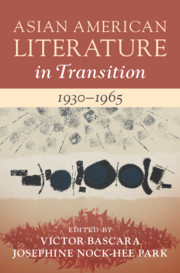Book contents
- Asian American Literature in Transition, 1930–1965
- Asian American Literature In Transition
- Asian American Literature in Transition, 1930–1965
- Copyright page
- Contents
- Figures
- Contributors
- Series Preface
- Introduction
- Part I Transitions Approached through Concepts and History
- Part II Transitions Approached through Authors, Texts, Concepts, and History
- Chapter 8 Lin Yutang and the Invention of Asian America, 1949
- Chapter 9 H. T. Tsiang Against the World
- Chapter 10 “A Congressman from India”
- Chapter 11 Younghill Kang, Transpacific Agent
- Chapter 12 Transition and Obliteration
- Chapter 13 America Is in the Heart as Postcolonial Pastoral
- Chapter 14 Bienvenido Santos
- Chapter 15 Women Writing War in Asia/America
- Chapter 16 Japanese Incarceration, Settler Colonialism
- Chapter 17 Jade Snow Wong and the Making of Model Minority Democracy
- Chapter 18 A Little Bit of Form Goes a Long Way
- Chapter 19 Richard Eun-kook Kim
- Select Bibliography
- Index
Chapter 15 - Women Writing War in Asia/America
from Part II - Transitions Approached through Authors, Texts, Concepts, and History
Published online by Cambridge University Press: 27 May 2021
- Asian American Literature in Transition, 1930–1965
- Asian American Literature In Transition
- Asian American Literature in Transition, 1930–1965
- Copyright page
- Contents
- Figures
- Contributors
- Series Preface
- Introduction
- Part I Transitions Approached through Concepts and History
- Part II Transitions Approached through Authors, Texts, Concepts, and History
- Chapter 8 Lin Yutang and the Invention of Asian America, 1949
- Chapter 9 H. T. Tsiang Against the World
- Chapter 10 “A Congressman from India”
- Chapter 11 Younghill Kang, Transpacific Agent
- Chapter 12 Transition and Obliteration
- Chapter 13 America Is in the Heart as Postcolonial Pastoral
- Chapter 14 Bienvenido Santos
- Chapter 15 Women Writing War in Asia/America
- Chapter 16 Japanese Incarceration, Settler Colonialism
- Chapter 17 Jade Snow Wong and the Making of Model Minority Democracy
- Chapter 18 A Little Bit of Form Goes a Long Way
- Chapter 19 Richard Eun-kook Kim
- Select Bibliography
- Index
Summary
This chapter reads the lives of two Asian/American women writers, Helena Kuo (1911–1999) and Eileen Chang (1920–1995). Both were born into wealthy families, and both received educations not usually available to women in China; but the political instabilities that eventually led to the Second Sino-Japanese War in 1937, and the wider Asia-Pacific War that started in 1941, disrupted formative periods of their lives, and both eventually found themselves refugees in the USA in the late 1940s. Kuo and Chang nevertheless became important writers on both sides of the Pacific, each in her own way bringing a modernizing China to life for American audiences – but their lives could not have turned out more differently. While Kuo was feted, welcomed by Eleanor Roosevelt at the White House, Chang struggled to find publishers for the work she produced after arriving in the USA and finally died a recluse. The contrasting receptions of their work reflect variations in American attitudes toward its new immigrants from Asia, and this chapter focuses on the valuable, if distinct, insights into the experiences of war and modernization in the mid-twentieth century elaborated in their American writings.
Keywords
- Type
- Chapter
- Information
- Asian American Literature in Transition, 1930–1965 , pp. 265 - 280Publisher: Cambridge University PressPrint publication year: 2021



